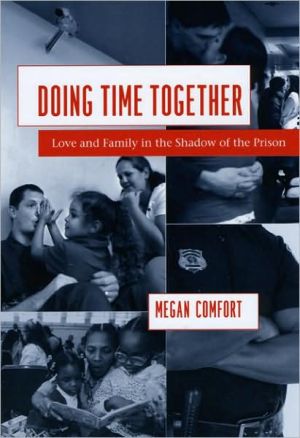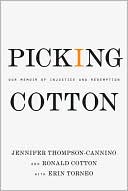Doing Time Together: Love and Family in the Shadow of the Prison
By quadrupling the number of people behind bars in two decades, the United States has become the world leader in incarceration. Much has been written on the men who make up the vast majority of the nation’s two million inmates. But what of the women they leave behind? Doing Time Together vividly details the ways that prisons shape and infiltrate the lives of women with husbands, fiancés, and boyfriends on the inside.\ Megan Comfort spent years getting to know women visiting men at San Quentin...
Search in google:
By quadrupling the number of people behind bars in two decades, the United States has become the world leader in incarceration. Much has been written on the men who make up the vast majority of the nation’s two million inmates. But what of the women they leave behind? Doing Time Together vividly details the ways that prisons shape and infiltrate the lives of women with husbands, fiancés, and boyfriends on the inside.Megan Comfort spent years getting to know women visiting men at San Quentin State Prison, observing how their romantic relationships drew them into contact with the penitentiary. Tangling with the prison’s intrusive scrutiny and rigid rules turns these women into “quasi-inmates,” eroding the boundary between home and prison and altering their sense of intimacy, love, and justice. Yet Comfort also finds that with social welfare weakened, prisons are the most powerful public institutions available to women struggling to overcome untreated social ills and sustain relationships with marginalized men. As a result, they express great ambivalence about the prison and the control it exerts over their daily lives.An illuminating analysis of women caught in the shadow of America’s massive prison system, Comfort’s book will be essential for anyone concerned with the consequences of our punitive culture. Journal of Social Welfare and Family Law "The depth and authenticity of [Comfort's] fieldwork, and the constant weaving in of the women's stories, makes this book much more than just an academic text. . . . A rich and thoroughly engaging book that illuminates hitherto hidden consequences of both the US and UK punitiv eculture and should cause policy-makers to reconsider the purpose of imprisonment and who indeed is being punished."— Lucy Gampell
1 Outside the Prison Walls 12 "On-Line" at San Quentin 213 "We Share Everything We Can the Best Way We Can" 654 "Papa's House": The Prison as Domestic Satellite 995 "It's a Lot of Good Men behind Walls!" 1266 The Long Way Home 185App. 1 Setting and Methods 199App. 2 An Orientation to the Research Literature 214App. 3 United States Carceral Population, 1980-2000 223App. 4 Field Documents 225References 231Index 251
\ Journal of Social Welfare and Family LawThe depth and authenticity of [Comfort's] fieldwork, and the constant weaving in of the women's stories, makes this book much more than just an academic text. . . . A rich and thoroughly engaging book that illuminates hitherto hidden consequences of both the US and UK punitiv eculture and should cause policy-makers to reconsider the purpose of imprisonment and who indeed is being punished.\ — Lucy Gampell\ \ \ \ \ \ David Garland“In this meticulous ethnography, Megan Comfort documents how the wives and girlfriends of inmates experience, directly and vicariously, the pains of confinement and the humiliations of imprisonment. But she also shows how these women rework their ideals of romance and relationships to adapt to the realities of prison, and, most remarkably, how they sometimes use their partner’s incarceration to their advantage in shaping the terms of their relationships. This beautifully written book does a brilliant job of tracing this, and other, complex truths in a detached, detailed, and thoroughly insightful manner.”--David Garland, author of The Culture of Control\ \ \ \ William Julius Wilson“Megan Comfort’s book on how a large correctional facility changes the behavior of women partners of prisoners is a tour de force. Doing Time Together is one of those rare studies with information and insights that are totally new and surprising. This well-written and engaging book will be widely read and could become a classic.”\ \ \ \ \ \ Arlie Hochschild“Ninety-three percent of the nation’s prisoners are men. So what happens to their wives and girlfriends? In her deeply insightful and beautifully written book, Megan Comfort gives us an unexpected answer. With their endless pre-visit waits in the ‘tube,’ dreaded encounters with hostile guards, and strict rules on clothing, they are ‘convicted’ too. But paradoxically, prison can also make once-violent or drug-addicted men into more stable, loyal, and loving partners. We put down this brilliant book wondering where the women’s prison really is—in or outside the prison walls?”\ \ \ \ \ \ Journal of Social Welfare and Family Law"The depth and authenticity of [Comfort's] fieldwork, and the constant weaving in of the women's stories, makes this book much more than just an academic text. . . . A rich and thoroughly engaging book that illuminates hitherto hidden consequences of both the US and UK punitiv eculture and should cause policy-makers to reconsider the purpose of imprisonment and who indeed is being punished."\ \ \ \ \ \ Library JournalWhen Comfort (medicine, Ctr. for AIDS Prevention Studies, Univ. of California, San Francisco) was working at San Quentin State Prison in connection with her academic work, she became intrigued by the number of women who made regular prison visits. Why did they want to maintain a connection with these marginalized men? This work is Comfort's interviews with 50 women whom she calls "quasi-inmates." Her findings should astound readers who might tend to look at these women as lacking in good judgment. Comfort found that once the incarcerated men are getting the health and welfare provisions that prisons provide, the couples actually have more romantic and satisfying relationships than they had in the "free" world. So who cares? Not everyone, but people concerned with prisoners' rights and women's struggles will find much food for thought here. Others should try the chapter called "The Tube," about the part of San Quentin's structure through which visitors pass before getting to the main visiting area. Comfort's description of the transition between the free world and the prison world is a little gem. Recommended for academic and public libraries.\ —Frances Sandiford\ \ \








